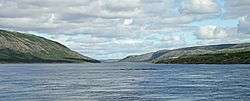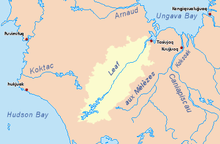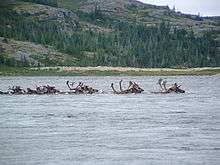Leaf River (Quebec)
Leaf River (French: Rivière aux Feuilles; Inuktitut: Kuugaaluk ["the large river"] or Itinniq ["where there are spring tides"][2]) is a river in northern Quebec, Canada, at the northern limit of the tree line. It flows from Lake Minto northeast through the Ungava Peninsula into Leaf Bay off Ungava Bay over a distance of 480 kilometres (300 mi).[3] At the head of Leaf Bay is the Inuit community of Tasiujaq.
| Leaf River Rivière aux Feuilles | |
|---|---|
 | |
 | |
| Location | |
| Country | Canada |
| Province | Quebec |
| Region | Nord-du-Québec |
| Physical characteristics | |
| Source | Lake Minto |
| • location | Nunavik |
| • coordinates | 57°13′07″N 75°00′45″W |
| • elevation | 181 m (594 ft) |
| Mouth | Leaf Bay (off Ungava Bay) |
• location | Tasiujaq |
• coordinates | 58°46′37″N 70°04′00″W |
• elevation | 0 m (0 ft) |
| Length | 480 km (300 mi)(includes Lake Minto)[1] |
| Basin size | 42,500 km2 (16,400 sq mi)[1] |
| Discharge | |
| • average | 590 m3/s (21,000 cu ft/s)[1] |
With caution, it is possible to paddle the entire Leaf River without portaging, as it contains no impassable waterfalls or non-navigable rapids.[4][5][6][7] The river's length, measured from Charpentier Bay to Tasiujaq, is 320 kilometres (200 mi); if measured from first discernable current, it is 288 kilometres (179 mi).[8]
The river is ice-free for about 60 days each year.[2]
Tributaries
The significant tributaries of the Leaf River are:[8]
- Charpentier River[4][6]
- Nedlouc River
- Descareaux River
- Daunais River
- Goudalie River
- Vizien River[5]
- Brissard River
- Qijuttuuk River
- Cohade River
- Tuktu River
- Dufreboy Creek
- Viennaux River
- Papijjusaq River
- Peladeau River
- Fanfan River
History
Since at least the late 19th century, the river has been known by its English name, "Leaf River", which was probably derived from the Arctic willow and birch trees that grow sparsely along its banks.[2] The Hudson's Bay Company fished there for salmon and porpoises, and opened a trading post at the mouth of the river around 1905. In the early 20th century, the French name Rivière des Feuilles was assigned, and standardized to its current form Rivière aux Feuilles in 1925.[3]
First known explorers:[9]
1898 - Albert Peter Low
1912 - Robert J. Flaherty
1976 - Bob Davis
The Leaf River caribou herd
 Caribou crossing Leaf River
Caribou crossing Leaf River.jpg) Leaf River and caribou
Leaf River and caribou
The Leaf River caribou herd (LRCH)[10] is a migratory forest-tundra ecotype of the boreal population, a caribou subspecies of Rangifer tarandus caribou. Like the George River Herd, it migrates between forest and tundra. Migratory caribou herds are often defined in terms of female natal philopatry or natal homing, the tendency to return to natal calving areas—in this case, the Leaf River. The Leaf Herd in the west, near the coast of Hudson Bay, increased from 270,000 in 1991 to 628,000 in 2001.[11] According to the Quebec's Natural Resources and Wildlife survey, the Leaf River Herd (LRH) (Rivière-aux-Feuilles) had decreased to 430,000 caribou in 2011.[12][13] According to an international study on caribou populations, the Leaf River herd could be threatened with extinction by 2080.[14]
References
- Natural Resources Canada, Atlas of Canada - Rivers Archived 2007-04-10 at the Wayback Machine
- FQCK (2000). Guide des parcours canotables du Quebec, Tome II. p. 233. ISBN 978-2-89000-504-4.
- "Rivière aux Feuilles" (in French). Commission de toponymie du Québec. Retrieved 2010-12-13.
- Lester Kovac and Lynette Chubb. "Charpentier/Leaf 2007".
- Bassi, Brad. "Northern Ungava Canoe Expedition". Archived from the original on 2008-07-19.
- Kunin, Tim. "Pakboats on the Leaf River". Archived from the original on 2010-12-12. Retrieved 2008-02-21.
- Lange, Willem. "Pakboats on the Rivière aux Feuilles". Archived from the original on 2010-12-12. Retrieved 2008-02-21.
- "Quebec Canoe Maps".
- Bruce W. Hodgins & Gwyneth Hoyle (1997). Canoeing North into the Unknown (A Record of River Travel: 1874-1974). pp. 216–217. ISBN 978-0-920474-93-8.
- "Woodland Caribou: Rangifer Tarandus" (PDF), Wildlife Division, Government of Newfoundland, 2009, archived from the original (PDF) on 26 November 2013, retrieved 14 January 2014
- Couturier, S.; Jean, D.; Otto, R.; Rivard, S. (2004), Demography of the migratory tundra caribou (Rangifer tarandus) of the Nord-du-québec region and Labrador (PDF), Québec: Ministère des Ressources Naturelles, de la Faune et des Parcs, Québec, and Direction de la recherche sur la faune, p. 68, archived from the original (PDF) on 2013-12-20
- "Nunavik's Leaf River caribou herd decreasing", Nunatsiaq News, Nunavik, 11 November 2011, retrieved 17 December 2011
- "Inuit, Inuu, Cree in Quebec and Labrador join forces to protect Ungava caribou: a united and powerful voice that will endeavor to preserve caribou", Nunatsiaq News, 26 April 2013, archived from the original on 15 January 2014, retrieved 14 January 2014
- Varga, Peter (20 December 2013), Warming climate threatens caribou in Nunavik, Labrador, Baffin: Study links species' survival with stable climate (PDF), Institute of Arctic Biology, retrieved 14 January 2014
External links
| Wikimedia Commons has media related to Leaf River. |